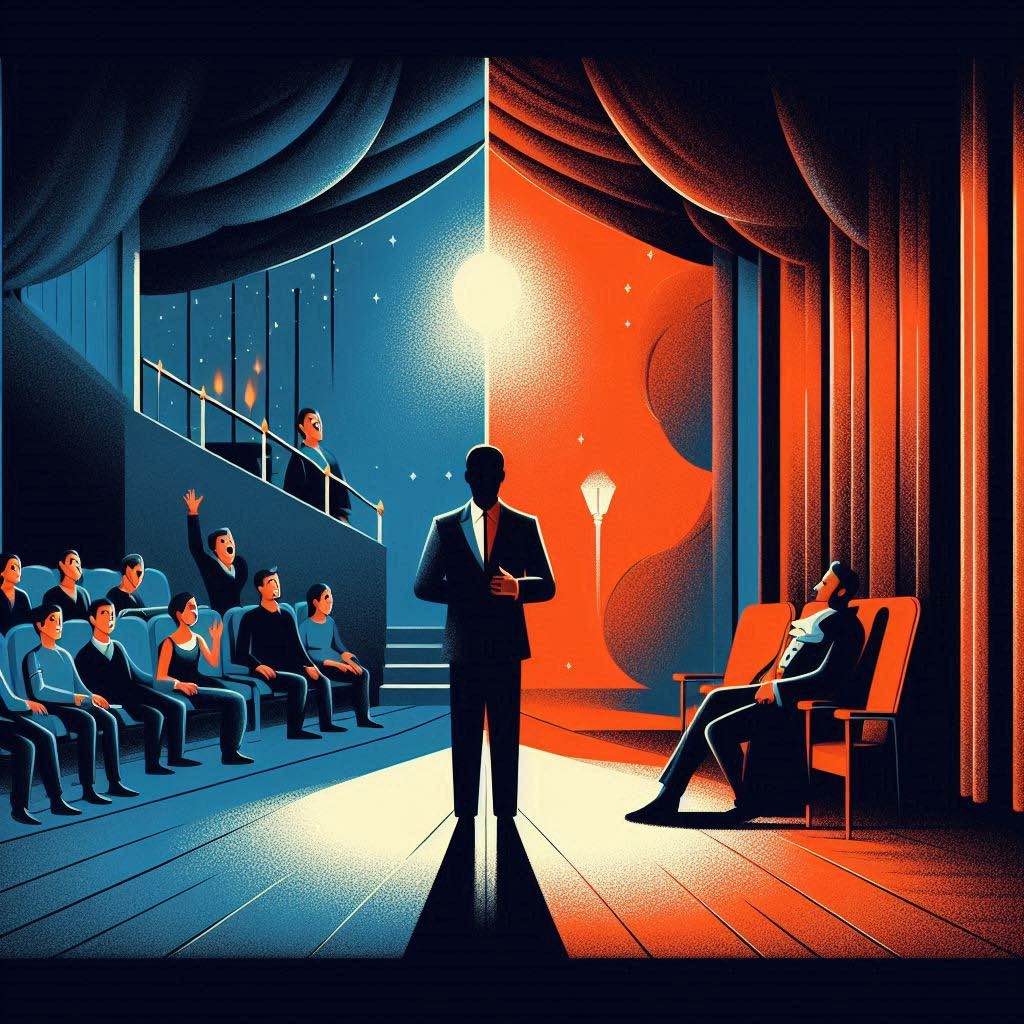In dramatic literature, understanding the distinction between a monologue and a soliloquy is essential. A monologue is a speech delivered by a character to other characters, often revealing vital plot points or emotions. On the other hand, a soliloquy is a character’s speech directed to themselves or the audience, providing insight into their internal thoughts and dilemmas.
The difference between soliloquy and monologue is crucial for appreciating the narrative techniques used in plays. Monologues engage other characters and propel the story forward, while soliloquies offer a window into the character’s mind, letting the audience in on secrets and inner conflicts.
Recognizing the unique functions of monologues and soliloquies enhances one’s understanding of a play’s structure and thematic depth. This knowledge allows audiences and readers to better interpret a playwright’s intentions and the emotional resonance of the characters.
Dramatic Monologues
As stated above, the purpose of a dramatic monologue is to reveal crucial aspects of the character’s identity, motivations, or emotions. This form of speech often drives the plot forward by providing insights or persuasion.
Key Characteristics of Dramatic Monologues
- Single Speaker: One character speaks, addressing other characters or the audience.
- Extended Speech: Typically longer than a typical dialogue exchange.
- Purposeful: It serves a specific purpose, such as character development or plot progression.
Functions in Drama
- Character Development: By listening to a character’s monologue, audiences gain deeper insight into their thoughts and feelings.
- Plot Advancement: The revelations and decisions made during monologues catalyze key plot events.
- Exposition: Monologues can provide background information or context that is crucial to understanding the story.
Alice in Wonderland Monologues
Alice in Wonderland (1865), written by Lewis Carroll, features several memorable monologues that give insight into the characters and the whimsical world they inhabit.
One of Alice’s notable monologues occurs when she encounters the disappearing Cheshire Cat. She expresses her frustration and curiosity, revealing her confusion in this strange land. Her observations and questions provide a window into her thoughts as she navigates Wonderland.
Why, how impolite of him. I asked him a civil question, and he pretended not to hear me.
Chapter 1 “Down the Rabbit Hole”, Alice in Wonderland by Lewis Carroll
That’s not at all nice. … I say, Mr. White Rabbit, where are you going? Hmmm. He won’t answer me.
And I do so want to know what he is late for. I wonder if I might follow him. Why not? There’s no rule
that I can’t go where I please. I–I will follow him. Wait for me, Mr. White Rabbit. I’m coming, too!
In another monologue, Alice speaks to the White Rabbit, who continuously eludes her. She confronts her feelings of being ignored and expresses a blend of irritation and bewilderment. This speech showcases her determination and evolving view of the nonsensical world around her.
Monologues in Alice in Wonderland serve not just as a narrative device but also as a means to highlight the surreal and often absurd nature of Carroll’s creation. They add depth to Alice’s character, making her more relatable as she vocalizes her thoughts and feelings amidst the chaos.
Soliloquy Examples
Soliloquies, on the other hand, are unique to dramatic literature, providing insight into a character’s inner thoughts and emotions. They are distinct from monologues, which are speeches delivered to other characters or the audience.
As noted earlier, a monologue involves a character speaking at length to other characters or the audience. For instance, Marc Antony’s speech in Shakespeare’s Julius Caesar (“Friends, Romans, countrymen, lend me your ears…”) is a monologue aimed at the crowd, revealing his intentions and persuading the public.
In contrast, a soliloquy is a speech delivered by a character who is alone on stage or believes they are alone, revealing their innermost thoughts. A classic example, and perhaps the most famous, is Hamlet’s soliloquy (“To be, or not to be…”), where he contemplates life and death in a deeply personal and introspective manner.
Soliloquy of Lady Macbeth
Lady Macbeth’s soliloquy in Act 1, Scene 5 of Macbeth is another powerful example of Shakespeare’s use of this dramatic device. In her speech, she reveals her determination and ambition.
Surrounded by the walls of her castle, Lady Macbeth learns of King Duncan’s upcoming visit. She prepares herself mentally and emotionally to seize the opportunity.
The raven himself is hoarse that croaks the fatal entrance of Duncan under my battlements.
She calls upon supernatural forces to assist her in shedding any feminine weakness.
Key Lines:
- “Come, you spirits that tend on mortal thoughts, unsex me here.”
- “And fill me from the crown to the toe top-full of direst cruelty.”
This speech demonstrates her resolve and willingness to embrace darkness to achieve her goals. She fears Macbeth may be too kind to follow through with their plan. Her inner thoughts, expressed through the soliloquy, highlight her strength and ruthlessness. The speech sets the tone for the ensuing events in the play.
Further Reading
Monologue vs. Soliloquy by Marius Alza, Grammar.com
Soliloquy, Aside, Monologue, and Dialogue in Shakespeare: How to Understand the Difference by Jule Romans, Owlcation
What is the difference between monologue and soliloquy? Or are they a synonym? on Reddit




